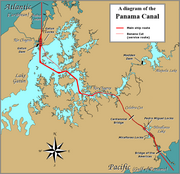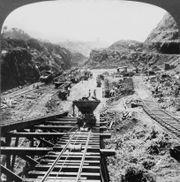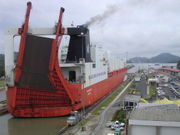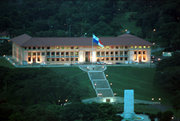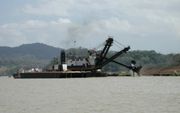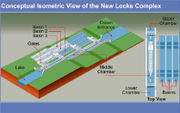Panama Canal
2007 Schools Wikipedia Selection. Related subjects: Air & Sea transport
The Panama Canal (Spanish: Canal de Panamá) is a major ship canal that traverses the Isthmus of Panama in Central America, connecting the Atlantic and Pacific Oceans. Construction of the canal was one of the largest and most difficult engineering projects ever undertaken. It has had an enormous impact on shipping between the Pacific and Atlantic oceans, obviating the long and treacherous route via the Drake Passage and Cape Horn at the southernmost tip of South America. A ship sailing from New York to San Francisco via the canal travels 9,500 kilometres (6,000 mi), well under half the distance of the previous 22,500 kilometre (14,000 mi) route around Cape Horn. Although the concept of a canal in Panama dates back to the early 16th century, the first attempt to construct a canal began in 1880 under French leadership. After this attempt collapsed, the work was finally completed by the United States, and the canal opened in 1914.The building of the 77 kilometre (48 mi) canal was plagued by problems, including disease (particularly malaria and yellow fever) and landslides. As many as 27,500 workers are estimated to have died during construction of the canal.
Since opening, the canal has been enormously successful, and continues to be a key conduit for international shipping. Each year the canal accommodates the passage of more than 14,000 ships, carrying more than 203 million tonnes of cargo. By 2002 about 800,000 ships had passed through the canal.
The canal can accommodate vessels from small private yachts up to fairly large commercial ships. The maximum size of vessel which can use the canal is known as Panamax; an increasing number of modern ships exceed this limit, and are known as post-Panamax vessels. A typical passage through the canal by a cargo ship takes around nine hours. 14,011 vessels passed through the canal in 2005, with a total capacity of 278.8 million tons, making an average of almost 40 vessels per day.
Layout
The canal consists of two artificial lakes, several improved and artificial channels, and three sets of locks. An additional artificial lake, Alajuela Lake, acts as a reservoir for the canal. The layout of the canal as seen by a ship transiting from the Pacific end to the Atlantic is as follows:
Due to the local geography the main direction of sailing is North-West, whereas the global direction from Pacific to Atlantic is East.
- From the beginning of the buoyed entrance channel in the Gulf of Panama, ships travel 13.2 kilometres (8.2 mi) up the channel to the Miraflores locks, passing under the Bridge of the Americas
- The two-stage Miraflores lock system, including the approach wall, is 1.7 kilometres (1.1 mi) long, with a total lift of 16.5 metres (54 ft) at mid-tide
- The artificial Miraflores Lake is the next stage, 1.7 kilometres (1.0 mi) long, and 16.5 metres (54 ft) above sea level
- The single-stage Pedro Miguel lock, which is 1.4 kilometres (0.8 mi) long, is the last part of the ascent with a lift of 9.5 metres (31 ft) up to the main level of the canal
- The Gaillard (Culebra) Cut slices 12.6 kilometres (7.8 mi) through the continental divide at an altitude of 26 metres (85 ft), and passes under the Centennial Bridge
- The Chagres River (Río Chagres), a natural waterway enhanced by the damming of Lake Gatún, runs west about 8.5 kilometres (5.3 mi), merging into Lake Gatun
- Gatun Lake, an artificial lake formed by the building of the Gatun Dam, carries vessels 24.2 kilometres (15.0 mi) across the isthmus
- The Gatún locks, a three-stage flight of locks 1.9 kilometres (1.2 mi) long, drop ships back down to sea level
- A 3.2 kilometre (2.0 mi) channel forms the approach to the locks from the Atlantic side
- Limón Bay (Bahía Limón), a huge natural harbour, provides an anchorage for some ships awaiting transit, and runs 8.7 kilometres (5.4 mi) to the outer breakwater
History
The earliest mention of a canal across the isthmus of Central America dates back to 1534, when Charles V, Holy Roman Emperor and king of Spain, suggested that a canal in Panama would ease the voyage for ships traveling to and from Ecuador and Peru.
Given the strategic situation of Central America as a narrow land dividing two great oceans, other forms of trade links were attempted over the years. The ill-fated Darien scheme was an attempt launched by the Kingdom of Scotland in 1698 to set up an overland trade route, but was defeated by the generally inhospitable conditions, and abandoned in 1700. Finally, the Panama Railway was built across the isthmus, opening in 1855. This overland link greatly facilitated trade, and this vital piece of infrastructure was a key factor in the selection of the later canal route.
An all-water route between the oceans was still seen as the ideal solution, and the idea of a canal was revived at various times, and for various routes; a route through Nicaragua was investigated several times. Finally, enthused by the success of the Suez Canal, the French, under Ferdinand de Lesseps, began construction on a sea-level canal (i.e., without locks) through the province of Panama (as it was then) on January 1, 1880. In 1893, after a great deal of work, the French scheme was abandoned due to disease and the sheer difficulty of building a sea-level canal. The high death toll was one of the major factors in the failure: although no detailed records were kept, as many as 22,000 workers are estimated to have died during the main period of French construction (1881 – 1889).
The United States, under Theodore Roosevelt, bought out the French equipment and excavations, and began work in 1904, after helping Panama to declare independence from Colombia in exchange for control of the Panama Canal Zone. A significant investment was made in eliminating disease from the area, particularly yellow fever and malaria, the causes of which had recently been discovered (see Health measures during the construction of the Panama Canal). With the diseases under control, and after significant work on preparing the infrastructure, construction of an elevated canal with locks began in earnest. The canal was formally opened on August 15, 1914 with the transit of the cargo ship Ancon.
The advances in hygiene resulted in a relatively low death toll during the American construction; still, 5,609 workers died during this period (1904 – 1914). This brought the total death toll for the construction of the canal to around 27,500.
By the 1930s it was seen that water supply would be an issue for the canal; this prompted the building of the Madden Dam across the Chagres River above Gatun Lake. The dam, completed in 1935, created Alajuela Lake, which acts as additional water storage for the canal. In 1939, construction began on a further major improvement: a new set of locks for the canal, large enough to carry the larger warships which the U.S. had under construction, or planned for future construction. The work proceeded for several years, and significant excavation was carried out on the new approach channels; but the project was cancelled after World War II.
After the war, United States control of the canal and the Canal Zone surrounding it became contentious as relations between Panama and the U.S. became increasingly tense. Many Panamanians felt that the canal zone rightfully belonged to Panama; student protests were met by the fencing in of the zone and an increased military presence. Negotiations toward a new settlement began in 1974, and resulted in the Torrijos-Carter Treaties. Signed by President of the United States Jimmy Carter and Omar Torrijos of Panama on September 7, 1977, this set in motion the process of handing the canal over to Panamanian control. Though controversial within the U.S., the treaty led to full Panamanian control effective at noon on December 31, 1999, and control of the canal was handed over to the Panama Canal Authority (ACP).
Before this handover, the government of Panama held an international bid to negotiate a 25-year contract for operation of the Canal's container shipping ports (chiefly two facilities at the Atlantic and Pacific outlets), which was won by the Chinese firm Hutchison Whampoa, a Hong Kong-based shipping concern whose owner Li Ka Shing is the wealthiest man in Asia.
Tolls
Tolls for the canal are decided by the Panama Canal Authority and are based on vessel type, size, and the type of cargo carried.
For container ships, the toll is assessed per " TEU" (Twenty-foot Equivalent Unit), which is the size of a container measuring 20 feet by 8 feet by 8.5 feet (6 m by 2.4 m by 2.6 m). Effective May 1, 2006, this toll is $49 per TEU. This is scheduled to rise to $54 on May 1, 2007. A Panamax container ship may carry up to 4,400 TEU. A reduced toll is charged for container ships "in ballast"; ie. travelling empty, with no cargo or passengers.
Most other types of vessel pay a toll per PC/UMS net ton, in which one "ton" is actually a volume of 100 cubic feet (2.8 m³). (The calculation of tonnage for commercial vessels is quite complex.) As of 2006, this toll is $2.96 per ton for the first 10,000 tons, $2.90 per ton for the next 10,000 tons, and $2.85 per ton thereafter. As with container ships, a reduced toll is charged for freight ships "in ballast".
Small vessels are assessed tolls based on their length. As of 2006, these are:
| Length of vessel | Toll |
|---|---|
| Up to 15.240 metres (50 ft) | $500 |
| More than 15.240 metres (50 ft) up to 24.384 metres (80 ft) | $750 |
| More than 24.384 metres (80 ft) up to 30.480 metres (100 ft) | $1,000 |
| More than 30.480 metres (100 ft) | $1,500 |
The most expensive toll for canal passage to date was charged on May 30, 2006 to the container ship Maersk Dellys, which paid $249,165.00 for passage. The least expensive toll was 36 cents to American adventurer Richard Halliburton who swam the canal in 1928. The average toll is around $54,000.
Current issues
More than ninety years since its opening, the canal continues to enjoy great success. Even though world shipping — and the size and design of ships themselves — have changed beyond recognition since the canal was designed, it continues to be a vital link in world trade, carrying more cargo than ever before, with less overhead. Nevertheless, the canal certainly faces a number of potential problems.
Efficiency and maintenance
There were fears that efficiency and maintenance would suffer following the U.S. withdrawal; however, this does not appear to be the case, and the canal's efficiency appears to be improving under Panamanian control. Canal Waters Time (CWT), the average time it takes a vessel to navigate the canal, including waiting time, is a key measure of efficiency; according to the ACP, CWT is decreasing. At the same time, the rate of accidents is at a record low.
Increasing volumes of imports from Asia which previously landed in the U.S. west coast ports are now travelling through the canal to the east coast. The total number of vessel transits in fiscal year 1999 was 14,336; this fell to a low of 13,154 in 2003, due at least in part to global economic factors, but has risen to 14,011 in 2005 (the canal’s fiscal year runs from October to September). However, this has been coupled with a steady rise in average ship size and in the numbers of Panamax vessels transiting, so that the total tonnage carried has risen steadily from 227.9 million PC/UMS tons in fiscal year 1999 to 278.8 million tons in 2005. Given the negative impact of vessel size on the rate of transits (for example, the inability of large vessels to cross in the Gaillard Cut), this represents significant overall growth in canal capacity, despite the reduction in total transits. The canal set a traffic record on March 16, 2004, with 1,005,551 PC/UMS tons of cargo transited in a single day; this was broken on March 13, 2006, when 1,070,023 PC/UMS tons transited the waterway.
The canal administration has invested nearly $1 billion in widening and modernizing the canal, with the aim of increasing capacity by 20%. The canal authority cites a number of major improvements, including the widening and straightening of the Gaillard Cut to reduce restrictions on crossing vessels, the deepening of the navigational channel in Gatun Lake to reduce draft restrictions and improve water supply, and the deepening of the Atlantic and Pacific Entrances of the Canal. This is supported by new vessels, such as a new drill barge and suction dredger, and an increase of the tugboat fleet by 20%. In addition, improvements have been made to the operating machinery of the canal, including an increased and improved tug locomotive fleet, the replacement of more than 16 kilometres of locomotive track, and new lock machinery controls. Improvements have been made to the traffic management system to allow more efficient control over ships in the canal.
The withdrawal of the U.S. has allowed Panama to sell excess electricity produced by the canal's dams, which was previously prohibited by the U.S. government. Only 25% of the hydroelectric power produced in the canal system is required to run the canal.
Capacity
The canal is presently handling more vessel traffic than had ever been envisioned by its builders. In 1934 it was estimated that the maximum capacity of the canal would be around 80 million tons per year; as noted above, canal traffic in 2005 consisted of 278.8 million tons of shipping.
Despite the gains which have been made in efficiency, the canal is soon expected to approach its maximum capacity. An additional complication is that the proportion of large (close to Panamax-sized) ships transiting is increasing steadily; this may result in a further reduction in the number of transits, even if cargo tonnage rises. In any case, if the canal is to continue to serve the needs of world shipping, action will be required to increase its capacity.
Competition
Despite having enjoyed a privileged position for many years, the canal is increasingly facing competition from other quarters. Although remote, speculation continues over a possible new canal through Mexico, Colombia or Nicaragua that will be capable of accommodating post-Panamax vessels, and two private proposals for a railway linking ports on the two coasts.
Critics have also voiced their concerns over the planned increase in canal tolls, suggesting that the Suez Canal may become a viable alternative for cargo en route from Asia to the U.S. East Coast. Nevertheless, demand for the Panama Canal continues to rise.
The increasing rate of melting of ice in the Arctic Ocean has led to speculation that the Northwest Passage may become viable for commercial shipping at some point in the future. This route would save 9,300 kilometres (5,800 mi) on the route from Asia to Europe compared with the Panama Canal, possibly leading to a diversion of some traffic to that route. However, such a route would still hold significant problems due to ice, as well as unresolved territorial issues.
Water issues
A significant problem is the decreasing average amount of water in Gatún Lake, caused largely by deforestation. 52 million gallons of fresh water from the lake are drained into the sea by the locks every time a ship transits the canal; and although there is sufficient annual rainfall to replenish the water used by the canal in a year, the seasonal nature of this rainfall means that the water must be stored from one rainy season to the next. Although Gatún lake can store some of this water, the rainforest has traditionally played a major role by absorbing this rain, and then releasing it at a steady rate into the lake. With the reduction in vegetation, rain flows quickly down the deforested slopes into the lake, from where the excess is spilled out into the ocean. This results in a shortfall of water during the dry season, when there is comparatively little water flowing to the lake to replenish it. Deforestation also causes silt to be more easily eroded from the area around Gatún Lake and collect at its bottom, reducing its capacity.
Future
With demand rising, the canal is positioned to be a significant feature of world shipping for the foreseeable future. However, changes in shipping patterns — particularly the increasing numbers of post-Panamax ships — will necessitate changes to the canal if it is to retain a significant market share. It is anticipated that by 2011, 37% of the world's container ships will be too large for the present canal, and hence a failure to expand would result in a significant loss of market share. The maximum sustainable capacity of the present canal, given some relatively minor improvement work, is estimated at between 330 and 340 million PC/UMS tons per year; it is anticipated that this capacity will be reached between 2009 and 2012. Close to 50% of transiting vessels are already using the full width of the locks.
An enlargement scheme similar to the 1939 Third Lock Scheme, to allow for a greater number of transits and the ability to handle larger ships, has been under consideration for some time. On April 4, 2006, the BBC reported that this enlargement scheme had been approved by the government of Panama. This proposal to expand the Canal was approved on a national referendum by approximately 80% on October 22, 2006.
Third Set of Locks Project
The current plan is for two new flights of locks: one to the east of the existing Gatún locks, and one southwest of Miraflores locks, each supported by approach channels. Each flight will ascend from ocean level direct to the Gatún Lake level; the existing two-stage ascent at Miraflores / Pedro Miguel will not be replicated. The new lock chambers will feature sliding gates, doubled for safety, and will be 427 metres (1,400 ft) long, 55 metres (180 ft) wide, and 18.3 metres (60 ft) deep; this will allow for the transit of vessels with a beam of up to 49 metres (160 ft), an overall length of up to 366 metres (1,200 ft) and a draft of up to 15 metres (50 ft), equivalent to a container ship carrying around 12,000 20-foot (6.1 m) long containers (TEU).
The new locks will be supported by new approach channels, including a 6.2 kilometre (3.8 mi) channel at Miraflores from the locks to the Gaillard Cut, skirting around Miraflores Lake. Each of these channels will be 218 metres (715 ft) wide, which will require post-Panamax vessels to navigate the channels in one direction at a time. The Gaillard Cut and the channel through Gatún Lake will be widened to no less than 280 metres (918 ft) on the straight portions and no less than 366 metres (1,200 ft) on the bends. The maximum level of Gatún Lake will be raised from reference height 26.7 metres (87.5 ft) to 27.1 metres (89 ft).
Each flight of locks will be accompanied by nine water reutilisation basins (three per lock chamber), each basin being approximately 70 metres (230 ft) wide, 430 metres (1410 ft) long and 5.50 metres (18 ft) deep. These gravity-fed basins will allow 60% of the water used in each transit to be reused; the new locks will consequently use 7% less water per transit than each of the existing lock lanes. The deepening of Gatún Lake, and the raising of its maximum water level, will also provide significant extra water storage capacity. These measures are intended to allow the expanded canal to operate without the construction of new reservoirs.
The estimated cost of the project is approximately $5.25 billion. The project is designed to allow for an anticipated growth in traffic from 280 million PC/UMS tons in 2005 to nearly 510 million PC/UMS tons in 2025; the expanded canal will have a maximum sustainable capacity of approximately 600 million PC/UMS tons per year. Tolls will continue to be calculated based on vessel tonnage, and will not depend on the locks used.
The new locks are expected to open for traffic in 2015. The present locks, which will be 100 years old by that time, will then have greater access for maintenance, and are projected to continue operating indefinitely.
